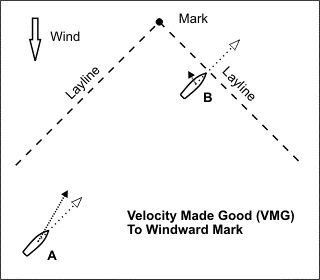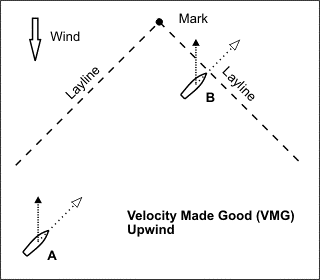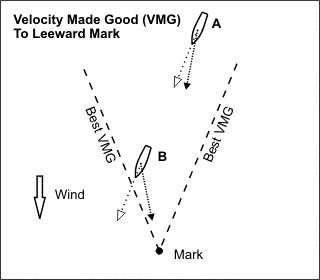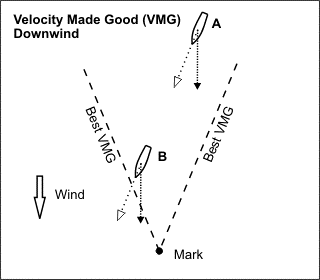 VMG
to Windward Mark
VMG
to Windward MarkSummary: The key to winning sailboat races is boat speed. The difference between winners and losers is typically quite small, often no more than an average of one or two 10ths of a knot in boat speed. Maximizing Velocity Made Good (VMG) to the wind (not GPS) yields the best performance in sailboat racing, both upwind and downwind, by finding the optimum Apparent Wind Angle (AWA).
Contents
One of the most challenging aspects of sailing is that we can't simply sail directly into the wind -- because we have to sail at a substantial angle to the wind, we have to zigzag when the objective is directly to windward.
The challenge when racing (or even when performance cruising) to windward is to know how high to point into the wind (pointing angle). When pointing higher (into the wind), the boat goes slower, but has less distance to travel; when pointing lower (away from the wind), the boat goes faster, but has more distance to travel. The trick is to find the optimum pointing angle that balances speed with distance sailed.
We can measure how well we're doing when going to windward by computing our net speed, which is different from our speed through the water, due to the angle from the boat's course. That net speed is called velocity made good (VMG for short), and is typically measured in two different ways.
 VMG
to Windward Mark
VMG
to Windward MarkSince the basic objective when racing is to get around the next mark as quickly as possible, VMG to the mark is clearly important. However, it's not a terribly useful measurement by itself because it's constantly changing, even when the boat stays on the optimum pointing angle. In the diagram at the right (VMG to Windward Mark), Boat A is a considerable distance from the mark, so VMG to the mark (the solid arrow) is nearly the same as speed through the water (the hollow arrow). Since Boat B is nearly at the layline, the point at which it should tack, its VMG to the mark is approaching a minimum (nearing zero), even though it has the same pointing angle and the same speed through the water as Boat A. Consequently, a boat can't easily tell from VMG to the mark alone how well it's sailing, since the best VMG to the mark at any given point is not obvious, and since actual VMG to the mark will be steadily going down after each tack even when the boat maintains the optimum pointing angle, suggesting that the boat is sailing less and less well even when it's not.
(Laylines are imaginary lines to the windward mark based on the optimum pointing angle. If a boat tacks onto the layline, it can just make the mark at the optimum pointing angle. If it goes beyond the layline, it's sailed too far or overstood the mark, and will lose ground to boats that stay within the laylines. Thus the two laylines form a cone in which a boat should normally stay.)
 VMG
Upwind
VMG
UpwindTo avoid the problem with VMG to the mark, we can instead use a different type of VMG that measures net speed (directly) into the wind, called VMG upwind, rather than net speed toward the mark. In the diagram at the left (VMG Upwind), boats A and B are in the same positions as in the prior diagram (VMG to Windward Mark), but both have the same VMG upwind (solid arrows) since both are on the optimum pointing angle, traveling through the water at the same speed.
When a boat sails higher than the optimum pointing angle, VMG upwind goes down because the loss in speed is greater than the decrease in distance. Likewise, when a boat sails lower than the optimum pointing angle, VMG upwind goes down because the increase in distance is greater than the increase in speed. Hence, VMG upwind is very useful, because the optimum pointing angle can be found simply by maximizing VMG upwind, and since the best VMG upwind will be constant for a given set of conditions (e.g., wind speed). Nothing else really matters, as we confirm below.
It may not be intuitively obvious, but maximizing VMG upwind also maximizes VMG to the mark. That's because the laylines bound (enclose) the minimum distance to the mark (since sailing outside the laylines is extra distance, and all courses within the laylines are the same distance), and because a layline is always directly to windward as long as we stay within the layline cone. In other words, maximum VMG upwind is the fastest way to the layline, the boundary of the optimum courses to the mark.
Thus our basic job upwind is "simple:" maximize VMG upwind (through boat trim as well as course).
On a reach, the optimum course is a direct line (rhumb line) to the next mark. But how about downwind?
When the objective is directly downwind (dead downwind, or DDW), the temptation is to sail directly for the objective, because it's the shortest distance. Unfortunately, even though a direct course is possible, unless the wind is very strong a direct DDW course is actually slower than zigzagging downwind. That's because sails (even the best spinnakers) work poorly DDW. Up to a point, when the boat is sailed higher ("hotter" or more on a reach), sail efficiency increases, thereby increasing speed more than enough to offset the extra distance sailed. (Generally speaking, the faster the boat the more this matters and the higher the boat should be sailed.) Thus there is also a downwind cone, defined by optimum course lines, that's similar to the upwind cone defined by the laylines. When we're inside the downwind cone, we don't want to sail lower ("deeper" or more downwind) than the optimum course angle, and we don't want to go outside the downwind cone (because that would be sailing too far, just like with the upwind cone), so we have to zigzag (jibing). As a result, just like upwind, we care about net speed or velocity made good, which is again typically measured in two different ways.
 VMG
to Leeward Mark
VMG
to Leeward MarkLike VMG to the windward mark, VMG to the leeward mark is important, but not terribly useful by itself, and for the same reason. In the diagram at the right (VMG to Leeward Mark), Boat A is a considerable distance from the mark, so VMG to the mark (the solid arrow) is nearly the same as speed through the water (the hollow arrow). Since Boat B is nearly at the optimum course line (Best VMG), the point at which it should jibe, its VMG to the mark is approaching a minimum, even though it has the same optimum course and the same speed through the water as Boat A. Consequently, a boat can't easily tell from VMG to the mark alone how well it's doing, since the best VMG to the mark at any given point is not obvious, and since actual VMG to the mark will be steadily going down after each jibe even when the boat maintains the optimum course, suggesting that the boat is sailing less and less well even when it's not.
 VMG
Downwind
VMG
DownwindAgain, to avoid the problem with VMG to the mark, we can instead use a different type of VMG that measures net speed (directly) downwind, called VMG downwind, rather than net speed toward the mark. In the diagram at the left (VMG Downwind), boats A and B are in the same positions as in the prior diagram (VMG to Leeward Mark), but both have the same VMG downwind (solid arrows) since both are on the optimum course, traveling through the water at the same speed.
When a boat sails lower (deeper) than the optimum course, VMG downwind goes down because the loss in speed is greater than the decrease in distance. Likewise, when a boat sails higher (hotter) than the optimum course, VMG downwind goes down because the increase in distance is greater than the increase in speed. Hence, VMG downwind is very useful, because the optimum course can be found simply by maximizing VMG downwind, and since the best VMG downwind will be constant for a given set of conditions (e.g., wind speed). Nothing else really matters, as we confirm below.
Again, it may not be intuitively obvious, but maximizing VMG downwind also maximizes VMG to the mark. That's because the optimum course (Best VMG) lines bound (enclose) the minimum distance to the mark (since sailing outside these lines is extra distance, and all optimum courses within these lines are the same distance), and because an optimum course (Best VMG) line is always directly to leeward as long as we stay within the cone. In other words, maximum VMG downwind is the fastest way to the optimum course (Best VMG) line, the boundary of the optimum courses to the mark.
Thus our basic job downwind is "simple:" maximize VMG downwind (through boat trim as well as course).
The discussion above focuses primarily on the instability of VMG to the mark when a mark is not far away. There's another issue that comes into play even when the mark is far away: VMG to the mark will differ between one tack or jibe and the other tack or jibe whenever the boat is on one side of the cone or the other. For example, when a boat is going upwind over on the left side of the cone, VMG to the mark on starboard tack will be worse (because the boat is heading more away from the mark) than on port tack, even when both courses are equally good. Worse, the difference increases as the boat gets closer to the edge of the cone. Thus a boat trying to use VMG to the mark as a trim and course guide would tend to zigzag up the middle with many short tacks or jibes, which would tend to be costly. VMG upwind and VMG downwind avoid that issue.
So how do we go about maximizing VMG upwind and VMG downwind? It's actually pretty simple if the boat has instruments that calculate VMG upwind and VMG downwind (from speed through the water, apparent wind angle, and apparent wind speed), and many do. What won't really help is VMG to the mark as calculated by (say) GPS.
The thing to watch out for is that keelboats have a great deal of momentum, which can result in misleading VMG upwind and VMG downwind readings. If, for example, the boat is turned more into the wind, it takes time for it to slow down in response to the higher pointing angle, and during that time the VMG upwind will be inflated. Likewise if the boat is turned more downwind, it takes time for it to slow down in response to the lower (deeper) pointing angle, and during that time the VMG downwind will be inflated. Hence, drivers should not be looking at VMG upwind and VMG downwind for real-time feedback on how to drive. This instrument data is most useful to someone keeping track of multiple boat performance parameters under steady conditions, who then advises the driver on the optimum course. ("Pinching!")
Over time, winning boats will tend to be those that keep track of VMG upwind and VMG downwind for different wind speeds, as well as optimum pointing and running angles, because that's the best long-term feedback on steering and trimming for optimum boat speed.
11 May 2013
John
Thank you for sharing some of your wisdom with
us, I'm relatively new to racing and have been frustrated using the vmg to mark
as i was instructed. Looking forward to next race!!
26 Sep 2010
John,
Thanks for writing this, this is all pretty interesting
to me as I have been using VMG mark as you call it alone.
I don't know that
I am totally convinced that we should just use VMG wind and forget about VMG mark.
By the rules of the world the boat who has the best VMG to the mark will get their
first.
You bring up a good point when you say ". Thus a boat trying to use
VMG to the mark as a trim and course guide would tend to zigzag up the middle with
many short tacks or jibes, which would tend to be costly" but remember that it is
costly because your speed will decrease while you are making those maneuvers THUS
your VMG mark will decrease and therefore your average VMG mark will not be good.
If a boat didn't slow down at all during tacks then the fastest course upwind would
be an infinite number of tacks up the middle.
Also your pictures (very nice
graphics by the way) show the wind blowing down the middle of the course which is
never the case. This is where VMG mark shows the best upwind route (assuming a couple
assumptions).
Since boats loose speed while tacking there has to be some
happy medium between sailing straight up the middle and sailing out to the layline
immediately.
It almost seems to me (correct me if i'm wrong) that for a
given course you use VMG wind to make sure you are making the best of that course.
Now deciding what tack to be on VMG mark can be useful.
Neither of these
methods take into account other variables that are also important in sailing.
Let me know what you think, do I make any sense?
Thanks,
Pete
26 Sep 2010
Hi Pete,
Thanks for your comments.
If we take
wind and tide, the cost of tacking, and "optimal sailing" out of the equation,
all courses within the laylines are equally fast to the mark (equal
distances sailed at the same speed).
We normally don't want to sail
right up the middle, not only because tacks are costly, but also because any wind
shift favors one side of the course over the middle (and over the other side of
the course). The middle is faster if and only if there is better wind in the middle
than on both sides, which is usually not the case.
We normally don't
want to sail as far as the layline until closer to the mark because any wind shift
hurts boats on the layline (putting them over or under the new layline), because
it's more difficult to call laylines over longer distances, and because the chances
of an unfavorable shift tend to increase with distance.
So, generally speaking,
the best course to weather is on the (predicted) favored side of the course but
short of the layline.
VMG cannot tell us which course is favored. What it
can do is help us find "optimal sailing" (apparent wind angle, sail trim, boat trim,
etc.). The point of my article is to show how and why VMG to Mark is misleading
and unhelpful, and why VMG to Wind should be used as a proxy instead. VMG
to Mark does of course matter, but the number is unhelpful without a point of reference,
which is difficult to determine and constantly changing, whereas maximizing VMG
to Wind is always helpful.
Hope that helps,
John
p.s. Wind in my
diagrams is just direction, not force -- strength of wind is assumed to be the same
over the entire diagram.
26 Sep 2010
John,
I agree thanks again for the article, good stuff.
You can't just sail by electronics as you have mentioned, too many other variables
that are important. But once you have decided on a tack as favored, VMG to the wind
is a good tool.
 John
Navas has lifelong experience in racing all types of sailboats, from dinghies to
large offshore racers. Four times Banshee National Champion, competed in O'Day (U.S.
Singlehanded) Championship, NEISA Champion, plus regional and fleet championships.
John
Navas has lifelong experience in racing all types of sailboats, from dinghies to
large offshore racers. Four times Banshee National Champion, competed in O'Day (U.S.
Singlehanded) Championship, NEISA Champion, plus regional and fleet championships.